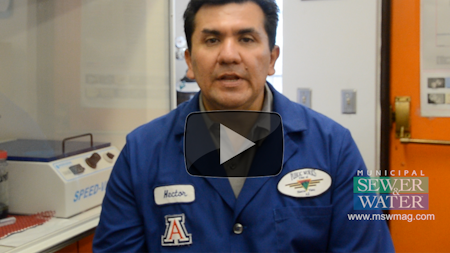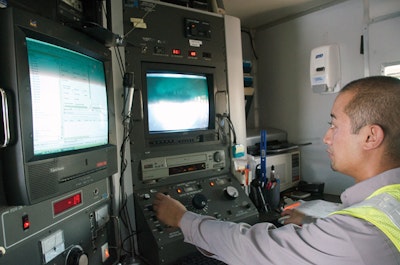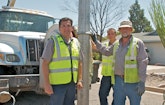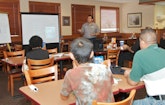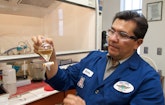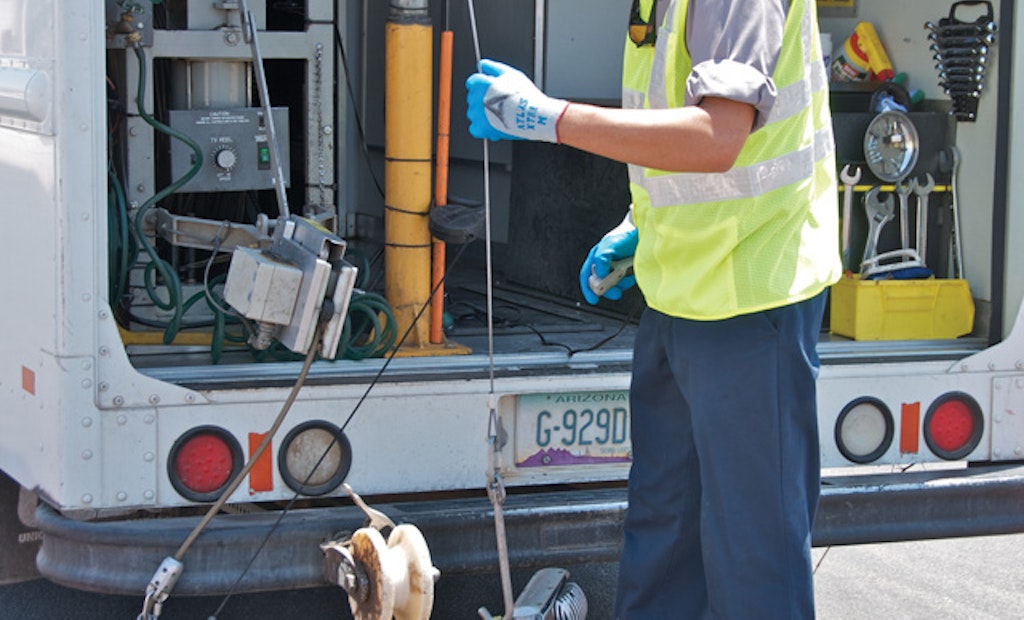Interested in Cleaning?
Get Cleaning articles, news and videos right in your inbox! Sign up now.
Cleaning + Get AlertsCleaning fat, oil, and grease blockages from sewers in Sierra Vista, Ariz., was an unending nightmare for Hector Hagele. He swore that if he ever had the chance to change how food establishments handled FOG, he would pursue it.
Hagele got his wish when the city built its Environmental Operations Park in 2002. The facility includes a 10-acre automated wastewater treatment plant that handles 4 mgd without chemical or mechanical means. FOG in the all-natural process would lower pH and affect the microorganisms, so engineers limited it to 25 mg/l at the headworks — the strictest requirement in the state.
Hagele, now a Grade 3 water and wastewater operator, also completed the Pretreatment Facility Inspection Program from California State University, Sacramento. That background, communication skills, and rapport led to his becoming the city’s pretreatment coordinator.
Hagele went restaurant to restaurant, educating owners about the effects of FOG. He developed relationships with Community Development and Engineering. He also established standards and construction guides for grease interceptors and directions on how pumpers should clean them. Restaurant owners and managers vilified him, but Hagele persevered, driving home the point that businesses generating waste products should be responsible for them.
Four years passed before the pretreatment program produced results. Today, hot spots are down from 17 to five, and only one is grease related. Overflows have been reduced from 12 to one per year. In 2007, the Arizona Water and Pollution Control Association named Hagele the Wastewater Pretreatment Operator of the Year.
Voyage of discovery
Before 2002, monsoons scoured the sewers, delivering huge chunks of grease to the headworks. One 7-foot-tall mound went through the bar screen, bent the chain and motor, and broke the screen. Vibrations from the impact moved the dump container to one side.
“People fight change, especially if it affects profit margins,” says Hagele. “But if you stay strong and true to your objective and overcome that fight, change will work. As proof, we haven’t had a problem at the headworks since 2007.”
Hagele began by visiting every business that could jeopardize the eight treatment lagoons. He stressed the proper way to dispose of waste and promoted a spirit of cooperation. “If you succeed, we succeed,” he told them, “and we will work with you to achieve that goal.”
Most food establishments didn’t even know what a grease trap was, or the difference between a trap and interceptor. “A grease trap is measured in pounds and an interceptor in gallons,” says Hagele. “A standard 40-pound grease trap holds 20 gallons. That’s too small to do any good.”
Hidden problems
The 2002 city standard specified that food establishments have a 1,500-gallon three-compartment grease interceptor with 5-gallon stand-alone sample box. When Hagele enforced the rule, managers went through the roof. One sandwich shop owner insisted that installing an interceptor was unnecessary because no food was cooked — and yet his grease trap was full.
Hagele tracked down the culprits — squeeze containers for ketchup, mayonnaise, and salad dressings. A health department rule prevents workers from topping off bottles, so they rinsed some 20 containers five to 20 times per day. “That’s a lot of FOG going down the drain,” says Hagele.
Even after the owner installed the interceptor, FOG samples averaged 360 mg/l. Hagele used the city’s SPE-DEX 1000XL extractor designed for [EPA] method 1664A from Horizon Technology to analyze samples. The manager solved the problem by putting baby bottle liners in the containers. When they are nearly empty, workers toss the liners in the trash.
“FOG is a bigger problem than most people realize,” says Hagele. “For example, soups have lots of fat, yet even my department thought only about fried foods. Broadening that mindset was one key to success.”
Dig in, stand firm
Another key was insisting on quality materials. Some concrete interceptors delivered to the city leaked, undermining the soil and causing larger leaks. In one case, the material was so porous that the tank burst under pressure. Another arrived green. Others had two compartments with provisions for a slide-in baffle.
Hagele asked Bob Camp, building administrator, to conduct 24-hour leak tests on the tanks. “This is one example of how the relationships I built with Public Works and City Hall proved invaluable,” he says. “My request was an extra headache for Bob, but he saw its value and agreed.”
Rejecting inadequate tanks and establishing construction standards had the desired effect. “The ones we receive now look like works of art,” says Hagele. “And business owners are assured of purchasing high-quality tanks.”
He then placed the burden of sizing grease interceptors on the city’s mechanical engineers. If the tanks failed the FOG limit, which Hagele increased to an achievable 100 mg/l, those engineers had to rectify the problem. They began calling Community Development and were referred to Hagele. He explained the sizing process and the importance of going larger rather than smaller.
“We hadn’t communicated with mechanical engineers before, and opening that channel was crucial,” says Hagele. “For instance, they allowed one woman to put a bakery in a strip mall without installing a grease interceptor.
“I didn’t see the zoning inspection until after the business opened. When I told the owner that she needed a grease trap to stay in business, she was beside herself, having spent all her money on equipment. This never would have happened had the engineer called me. Potential businesses need to know the facts from the moment they apply for the license.”
Communication with Community Development was another key as it enabled Hagele to examine permits, meet with new business owners, and explain pretreatment requirements. He also reviewed zoning inspections for compliance. “The teamwork between divisions has improved food service compliance from 10 percent when the program began to 85 percent,” he says.
Squeaky clean
Hagele’s biggest challenge was strip mall owners renting space without grease interceptors to food establishments. “No business will install a $20,000 interceptor in a rented building,” he says. “We told property owners not to rent to anyone unwilling to install an interceptor. They didn’t like that, so most landlords now split the cost with the lessees.”
Installing grease interceptors was only half the equation. Getting them clean was Hagele’s next challenge. He followed pumpers to learn what they did and saw that some cleaned a 3,000-gallon interceptor in as little as 15 minutes. After they left, he opened the tank. “They had pumped the sample box and removed the top layer of solidified grease, but left the greasy water,” he says.
Hagele showed such tanks to restaurant managers. He explained that the walls were thick with grease, which diminished the tank’s capacity, caused samples to exceed FOG limits, and increased the frequency of pumpouts. “It should take one-and-a-half hours to clean a full tank the first time,” says Hagele. “From then on, maintenance is simple.” When pumpers responded to the callback, managers made sure they pumped the water, then pressure washed or scraped the tank walls.
The experience made Hagele more aware of maintenance logs. If they showed recent cleanings, he opened the tanks for managers. Often, the compartments were full. “I explained that FOG left for long periods lowers pH, and acidic water will erode concrete interceptors in time,” he says. “They all became very attentive to the pumpers’ work, but the key was having someone inspect on a regular basis.”
Persuasive tools
Hagele has yet to fine or close non-compliant businesses — instead, he uses persistence and various persuasive tools to sway attitudes. Besides drawing monthly samples, he works with collections system crews to televise sewers downstream of resistant establishments using a CUES camera van and OZII pan-and-tilt camera on an Ultra Shorty 21 transporter. After creating a history on the pipe, he shows it to owners.
He suggests that if a stoppage occurred and properties were inundated, his documentation would stand up in court. “Reason with them like that and they’ll come around,” he says. “But it took four years of pulling samples and televising to see results.”
To educate the constantly changing restaurant personnel, Hagele created a slide presentation dramatizing what happens when FOG goes down the drain. Images show laterals and mains coated with it. Hagele equates FOG to cholesterol in arteries. His next image of a 100 percent blocked pipe is followed by a contractor saw-cutting a floor to remove a clog that overwhelmed a jet rodder. “They learn that our program protects infrastructure, property, and our wastewater facility process,” he says.
Hagele discovered another FOG source when he watched staff cleaning greasy kitchen mats in restaurant parking lots instead of in mop sinks. The detergents and hot water eroded the asphalt and ran into storm drains. Hagele specified that food establishments install 50-square-foot outside curbed washdown areas plumbed to the grease interceptor. “Once owners realized that they didn’t have to resurface the asphalt again, they accepted the idea,” he says.
Getting it right
While working with restaurants on FOG control, the city inspected and cleaned its 200 miles of sewer every year with a Vactor 2100 combination truck with 18-cubic-yard debris tank, dual-action water pump delivering 60 gpm/2,500 psi, and 1,000-gallon water tank with heat exchanger. Crews use a Warthog nozzle from StoneAge to remove grease and a floor cleaner with eight jets from KEG Technologies to clean debris in the inverts. But until the pretreatment program took root, they never caught up with the incoming FOG.
“It takes manpower and time to jet and vacuum grease, then dump it at our drying beds,” says Hagele. “By requiring properly sized and maintained grease interceptors, the FOG is gone and we clean the lines quicker and better.
“I don’t know where this program would be without the cooperation of city engineers, Community Development, sewer televising and cleaning crews, and other agencies. Their expertise made it possible to establish ordinances and standards that enabled us to get it right from the beginning.”
